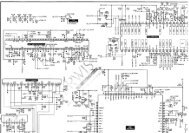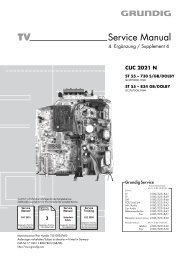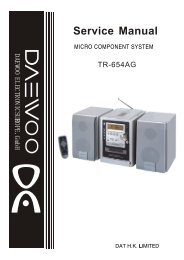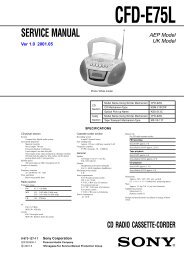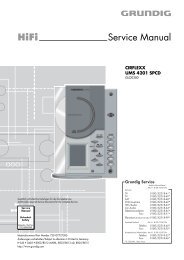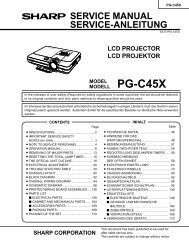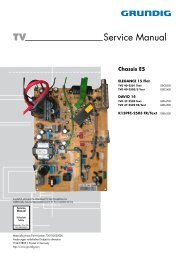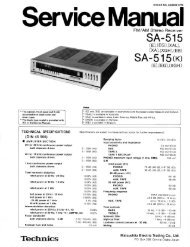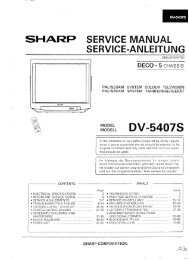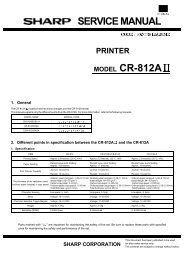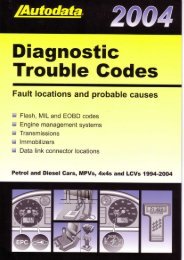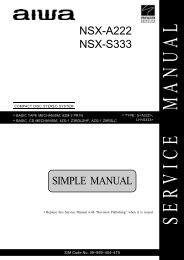LCD TV SERVICE MANUAL - diagramas.diagram...
LCD TV SERVICE MANUAL - diagramas.diagram...
LCD TV SERVICE MANUAL - diagramas.diagram...
You also want an ePaper? Increase the reach of your titles
YUMPU automatically turns print PDFs into web optimized ePapers that Google loves.
<strong>LCD</strong> <strong>TV</strong><br />
<strong>SERVICE</strong> <strong>MANUAL</strong><br />
CHASSIS : LP7BB<br />
MODEL : 32LB9RT 32LB9RT-MD<br />
MODEL : 32LB9RTE 32LB9RTE-MB<br />
CAUTION<br />
BEFORE SERVICING THE CHASSIS,<br />
READ THE SAFETY PRECAUTIONS IN THIS <strong>MANUAL</strong>.<br />
Internal Use Only<br />
website:http://biz.LGservice.com
Copyright © 2007 LG Electronics. Inc. All right reserved.<br />
Only for training and service purposes<br />
CONTENTS<br />
CONTENTS .............................................................................................. 2<br />
SAFETY PRECAUTIONS ..........................................................................3<br />
SPECIFICATION ........................................................................................6<br />
ADJUSTMENT INSTRUCTION ...............................................................10<br />
TROUBLE SHOOTING ............................................................................14<br />
BLOCK DIAGRAM...................................................................................25<br />
EXPLODED VIEW .................................................................................. 26<br />
EXPLODED VIEW PARTS LIST..............................................................27<br />
REPLACEMENT PARTS LIST ............................................................... 28<br />
SVC. SHEET ...............................................................................................<br />
- 2 -<br />
LGE Internal Use Only
Copyright © 2007 LG Electronics. Inc. All right reserved.<br />
Only for training and service purposes<br />
SAFETY PRECAUTIONS<br />
Many electrical and mechanical parts in this chassis have special safety-related characteristics. These parts are identified by in the<br />
Schematic Diagram and Replacement Parts List.<br />
It is essential that these special safety parts should be replaced with the same components as recommended in this manual to prevent<br />
Shock, Fire, or other Hazards.<br />
Do not modify the original design without permission of manufacturer.<br />
General Guidance<br />
An isolation Transformer should always be used during the<br />
servicing of a receiver whose chassis is not isolated from the AC<br />
power line. Use a transformer of adequate power rating as this<br />
protects the technician from accidents resulting in personal injury<br />
from electrical shocks.<br />
It will also protect the receiver and it's components from being<br />
damaged by accidental shorts of the circuitry that may be<br />
inadvertently introduced during the service operation.<br />
If any fuse (or Fusible Resistor) in this <strong>TV</strong> receiver is blown,<br />
replace it with the specified.<br />
When replacing a high wattage resistor (Oxide Metal Film Resistor,<br />
over 1W), keep the resistor 10mm away from PCB.<br />
Keep wires away from high voltage or high temperature parts.<br />
Before returning the receiver to the customer,<br />
always perform an AC leakage current check on the exposed<br />
metallic parts of the cabinet, such as antennas, terminals, etc., to<br />
be sure the set is safe to operate without damage of electrical<br />
shock.<br />
Leakage Current Cold Check(Antenna Cold Check)<br />
With the instrument AC plug removed from AC source, connect an<br />
electrical jumper across the two AC plug prongs. Place the AC<br />
switch in the on position, connect one lead of ohm-meter to the AC<br />
plug prongs tied together and touch other ohm-meter lead in turn to<br />
each exposed metallic parts such as antenna terminals, phone<br />
jacks, etc.<br />
If the exposed metallic part has a return path to the chassis, the<br />
measured resistance should be between 1MΩ and 5.2MΩ.<br />
When the exposed metal has no return path to the chassis the<br />
reading must be infinite.<br />
An other abnormality exists that must be corrected before the<br />
receiver is returned to the customer.<br />
IMPORTANT SAFETY NOTICE<br />
- 3 -<br />
Leakage Current Hot Check (See below Figure)<br />
Plug the AC cord directly into the AC outlet.<br />
Do not use a line Isolation Transformer during this check.<br />
Connect 1.5K/10watt resistor in parallel with a 0.15uF capacitor<br />
between a known good earth ground (Water Pipe, Conduit, etc.)<br />
and the exposed metallic parts.<br />
Measure the AC voltage across the resistor using AC voltmeter<br />
with 1000 ohms/volt or more sensitivity.<br />
Reverse plug the AC cord into the AC outlet and repeat AC voltage<br />
measurements for each exposed metallic part. Any voltage<br />
measured must not exceed 0.75 volt RMS which is corresponds to<br />
0.5mA.<br />
In case any measurement is out of the limits specified, there is<br />
possibility of shock hazard and the set must be checked and<br />
repaired before it is returned to the customer.<br />
Leakage Current Hot Check circuit<br />
To Instrument’s<br />
exposed<br />
METALLIC PARTS<br />
AC Volt-meter<br />
0.15uF<br />
1.5 Kohm/10W<br />
Replaceable batteries<br />
CAUTION<br />
RISK OF EXPLOSION IF BATTERY<br />
IS REPLACED BY AN INCORRECT<br />
TYPE. DISPOSE OF USED<br />
BATTERIES ACCORDING TO THE<br />
INSTRUCTIONS<br />
ADVARSEL<br />
Lithiumbatteri - Eksplosionsfare ved<br />
fejlagtig hándtening. Udskiftning má<br />
kun ske med batteri at samme<br />
fabrikat og type. Levér det brugte<br />
batteri tilbage til leverandoren<br />
Good Earth Ground<br />
such as WATER PIPE,<br />
CONDUIT etc.<br />
LGE Internal Use Only
CAUTION: Before servicing receivers covered by this service<br />
manual and its supplements and addenda, read and follow the<br />
SAFETY PRECAUTIONS on page 3 of this publication.<br />
NOTE: If unforeseen circumstances create conflict between the<br />
following servicing precautions and any of the safety precautions on<br />
page 3 of this publication, always follow the safety precautions.<br />
Remember: Safety First.<br />
General Servicing Precautions<br />
1. Always unplug the receiver AC power cord from the AC power<br />
source before;<br />
a. Removing or reinstalling any component, circuit board<br />
module or any other receiver assembly.<br />
b. Disconnecting or reconnecting any receiver electrical plug or<br />
other electrical connection.<br />
c. Connecting a test substitute in parallel with an electrolytic<br />
capacitor in the receiver.<br />
CAUTION: A wrong part substitution or incorrect polarity<br />
installation of electrolytic capacitors may result in an<br />
explosion hazard.<br />
2. Test high voltage only by measuring it with an appropriate high<br />
voltage meter or other voltage measuring device (DVM,<br />
FE<strong>TV</strong>OM, etc) equipped with a suitable high voltage probe.<br />
Do not test high voltage by "drawing an arc".<br />
3. Do not spray chemicals on or near this receiver or any of its<br />
assemblies.<br />
4. Unless specified otherwise in this service manual, clean<br />
electrical contacts only by applying the following mixture to the<br />
contacts with a pipe cleaner, cotton-tipped stick or comparable<br />
non-abrasive applicator; 10% (by volume) Acetone and 90% (by<br />
volume) isopropyl alcohol (90%-99% strength)<br />
CAUTION: This is a flammable mixture.<br />
Unless specified otherwise in this service manual, lubrication of<br />
contacts in not required.<br />
5. Do not defeat any plug/socket B+ voltage interlocks with which<br />
receivers covered by this service manual might be equipped.<br />
6. Do not apply AC power to this instrument and/or any of its<br />
electrical assemblies unless all solid-state device heat sinks are<br />
correctly installed.<br />
7. Always connect the test receiver ground lead to the receiver<br />
chassis ground before connecting the test receiver positive<br />
lead.<br />
Always remove the test receiver ground lead last.<br />
8. Use with this receiver only the test fixtures specified in this<br />
service manual.<br />
CAUTION: Do not connect the test fixture ground strap to any<br />
heat sink in this receiver.<br />
Electrostatically Sensitive (ES) Devices<br />
Some semiconductor (solid-state) devices can be damaged easily<br />
by static electricity. Such components commonly are called<br />
Electrostatically Sensitive (ES) Devices. Examples of typical ES<br />
devices are integrated circuits and some field-effect transistors and<br />
semiconductor "chip" components. The following techniques<br />
should be used to help reduce the incidence of component<br />
damage caused by static by static electricity.<br />
1. Immediately before handling any semiconductor component or<br />
semiconductor-equipped assembly, drain off any electrostatic<br />
charge on your body by touching a known earth ground.<br />
Alternatively, obtain and wear a commercially available<br />
discharging wrist strap device, which should be removed to<br />
prevent potential shock reasons prior to applying power to the<br />
Copyright © 2007 LG Electronics. Inc. All right reserved.<br />
Only for training and service purposes<br />
SERVICING PRECAUTIONS<br />
- 4 -<br />
unit under test.<br />
2. After removing an electrical assembly equipped with ES<br />
devices, place the assembly on a conductive surface such as<br />
aluminum foil, to prevent electrostatic charge buildup or<br />
exposure of the assembly.<br />
3. Use only a grounded-tip soldering iron to solder or unsolder ES<br />
devices.<br />
4. Use only an anti-static type solder removal device. Some solder<br />
removal devices not classified as "anti-static" can generate<br />
electrical charges sufficient to damage ES devices.<br />
5. Do not use freon-propelled chemicals. These can generate<br />
electrical charges sufficient to damage ES devices.<br />
6. Do not remove a replacement ES device from its protective<br />
package until immediately before you are ready to install it.<br />
(Most replacement ES devices are packaged with leads<br />
electrically shorted together by conductive foam, aluminum foil<br />
or comparable conductive material).<br />
7. Immediately before removing the protective material from the<br />
leads of a replacement ES device, touch the protective material<br />
to the chassis or circuit assembly into which the device will be<br />
installed.<br />
CAUTION: Be sure no power is applied to the chassis or circuit,<br />
and observe all other safety precautions.<br />
8. Minimize bodily motions when handling unpackaged<br />
replacement ES devices. (Otherwise harmless motion such as<br />
the brushing together of your clothes fabric or the lifting of your<br />
foot from a carpeted floor can generate static electricity<br />
sufficient to damage an ES device.)<br />
General Soldering Guidelines<br />
1. Use a grounded-tip, low-wattage soldering iron and appropriate<br />
tip size and shape that will maintain tip temperature within the<br />
range or 500°F to 600°F.<br />
2. Use an appropriate gauge of RMA resin-core solder composed<br />
of 60 parts tin/40 parts lead.<br />
3. Keep the soldering iron tip clean and well tinned.<br />
4. Thoroughly clean the surfaces to be soldered. Use a mall wirebristle<br />
(0.5 inch, or 1.25cm) brush with a metal handle.<br />
Do not use freon-propelled spray-on cleaners.<br />
5. Use the following unsoldering technique<br />
a. Allow the soldering iron tip to reach normal temperature.<br />
(500°F to 600°F)<br />
b. Heat the component lead until the solder melts.<br />
c. Quickly draw the melted solder with an anti-static, suctiontype<br />
solder removal device or with solder braid.<br />
CAUTION: Work quickly to avoid overheating the circuit<br />
board printed foil.<br />
6. Use the following soldering technique.<br />
a. Allow the soldering iron tip to reach a normal temperature<br />
(500°F to 600°F)<br />
b. First, hold the soldering iron tip and solder the strand against<br />
the component lead until the solder melts.<br />
c. Quickly move the soldering iron tip to the junction of the<br />
component lead and the printed circuit foil, and hold it there<br />
only until the solder flows onto and around both the<br />
component lead and the foil.<br />
CAUTION: Work quickly to avoid overheating the circuit<br />
board printed foil.<br />
d. Closely inspect the solder area and remove any excess or<br />
splashed solder with a small wire-bristle brush.<br />
LGE Internal Use Only
IC Remove/Replacement<br />
Some chassis circuit boards have slotted holes (oblong) through<br />
which the IC leads are inserted and then bent flat against the<br />
circuit foil. When holes are the slotted type, the following technique<br />
should be used to remove and replace the IC. When working with<br />
boards using the familiar round hole, use the standard technique<br />
as outlined in paragraphs 5 and 6 above.<br />
Removal<br />
1. Desolder and straighten each IC lead in one operation by gently<br />
prying up on the lead with the soldering iron tip as the solder<br />
melts.<br />
2. Draw away the melted solder with an anti-static suction-type<br />
solder removal device (or with solder braid) before removing the<br />
IC.<br />
Replacement<br />
1. Carefully insert the replacement IC in the circuit board.<br />
2. Carefully bend each IC lead against the circuit foil pad and<br />
solder it.<br />
3. Clean the soldered areas with a small wire-bristle brush.<br />
(It is not necessary to reapply acrylic coating to the areas).<br />
"Small-Signal" Discrete Transistor<br />
Removal/Replacement<br />
1. Remove the defective transistor by clipping its leads as close as<br />
possible to the component body.<br />
2. Bend into a "U" shape the end of each of three leads remaining<br />
on the circuit board.<br />
3. Bend into a "U" shape the replacement transistor leads.<br />
4. Connect the replacement transistor leads to the corresponding<br />
leads extending from the circuit board and crimp the "U" with<br />
long nose pliers to insure metal to metal contact then solder<br />
each connection.<br />
Power Output, Transistor Device<br />
Removal/Replacement<br />
1. Heat and remove all solder from around the transistor leads.<br />
2. Remove the heat sink mounting screw (if so equipped).<br />
3. Carefully remove the transistor from the heat sink of the circuit<br />
board.<br />
4. Insert new transistor in the circuit board.<br />
5. Solder each transistor lead, and clip off excess lead.<br />
6. Replace heat sink.<br />
Diode Removal/Replacement<br />
1. Remove defective diode by clipping its leads as close as<br />
possible to diode body.<br />
2. Bend the two remaining leads perpendicular y to the circuit<br />
board.<br />
3. Observing diode polarity, wrap each lead of the new diode<br />
around the corresponding lead on the circuit board.<br />
4. Securely crimp each connection and solder it.<br />
5. Inspect (on the circuit board copper side) the solder joints of<br />
the two "original" leads. If they are not shiny, reheat them and if<br />
necessary, apply additional solder.<br />
Fuse and Conventional Resistor<br />
Removal/Replacement<br />
1. Clip each fuse or resistor lead at top of the circuit board hollow<br />
stake.<br />
2. Securely crimp the leads of replacement component around<br />
notch at stake top.<br />
3. Solder the connections.<br />
CAUTION: Maintain original spacing between the replaced<br />
component and adjacent components and the circuit board to<br />
prevent excessive component temperatures.<br />
Copyright © 2007 LG Electronics. Inc. All right reserved.<br />
Only for training and service purposes<br />
- 5 -<br />
Circuit Board Foil Repair<br />
Excessive heat applied to the copper foil of any printed circuit<br />
board will weaken the adhesive that bonds the foil to the circuit<br />
board causing the foil to separate from or "lift-off" the board. The<br />
following guidelines and procedures should be followed whenever<br />
this condition is encountered.<br />
At IC Connections<br />
To repair a defective copper pattern at IC connections use the<br />
following procedure to install a jumper wire on the copper pattern<br />
side of the circuit board. (Use this technique only on IC<br />
connections).<br />
1. Carefully remove the damaged copper pattern with a sharp<br />
knife. (Remove only as much copper as absolutely necessary).<br />
2. carefully scratch away the solder resist and acrylic coating (if<br />
used) from the end of the remaining copper pattern.<br />
3. Bend a small "U" in one end of a small gauge jumper wire and<br />
carefully crimp it around the IC pin. Solder the IC connection.<br />
4. Route the jumper wire along the path of the out-away copper<br />
pattern and let it overlap the previously scraped end of the good<br />
copper pattern. Solder the overlapped area and clip off any<br />
excess jumper wire.<br />
At Other Connections<br />
Use the following technique to repair the defective copper pattern<br />
at connections other than IC Pins. This technique involves the<br />
installation of a jumper wire on the component side of the circuit<br />
board.<br />
1. Remove the defective copper pattern with a sharp knife.<br />
Remove at least 1/4 inch of copper, to ensure that a hazardous<br />
condition will not exist if the jumper wire opens.<br />
2. Trace along the copper pattern from both sides of the pattern<br />
break and locate the nearest component that is directly<br />
connected to the affected copper pattern.<br />
3. Connect insulated 20-gauge jumper wire from the lead of the<br />
nearest component on one side of the pattern break to the lead<br />
of the nearest component on the other side.<br />
Carefully crimp and solder the connections.<br />
CAUTION: Be sure the insulated jumper wire is dressed so the<br />
it does not touch components or sharp edges.<br />
LGE Internal Use Only
SPECIFICATION<br />
NOTE : Specifications and others are subject to change without notice for improvement.<br />
1. Application range<br />
This spec sheet is applied to the <strong>LCD</strong> <strong>TV</strong> used LP7BB<br />
chassis<br />
2. Specification<br />
Each part is tested as below without special appointment.<br />
(1) Temperature : 25 ± 5°C(77 ± 9°F), CST : 40 ± 5°C<br />
(2) Relative Humidity : 65% ± 10%<br />
(3) Power Voltage : Standard input voltage (100-240V~,<br />
50/60Hz)<br />
*Standard Voltage of each products is marked by models<br />
4. General <strong>TV</strong> Specification<br />
Copyright © 2007 LG Electronics. Inc. All right reserved.<br />
Only for training and service purposes<br />
- 6 -<br />
(4) Specification and performance of each parts are followed<br />
each drawing and specification by part number in<br />
accordance with BOM.<br />
(5) The receiver must be operated for about 20 minutes prior<br />
to the adjustment.<br />
3. Test method<br />
(1) Performance : LGE <strong>TV</strong> test method followed<br />
(2) Demanded other specification<br />
Safety : CE, IEC Specification<br />
EMC : CE, IEC<br />
No Item Specification Remark<br />
1. Video input applicable system NTSC-M, PAL M/N<br />
2. Receivable Broadcasting System 1) NTSC<br />
2) PAL M<br />
3) PAL N<br />
3. RF Input Channel BAND NTSC<br />
VHF 2 ~ 13<br />
UHF 14 ~ 69<br />
CA<strong>TV</strong> 1 ~ 125<br />
4. Input Voltage 100-240V~ / 50Hz, 60Hz<br />
5. Market Central & South America<br />
6. Operating Environment 1) Temp : 0 ~ 40 deg<br />
2) Humidity : 10 ~ 90 %RH<br />
7. Storage Environment 1) Temp : -20 ~ 50 deg<br />
2) Humidity : 10 ~ 90 %RH<br />
8. Power Consumption Power on ≤ 260(42”)<br />
(Green) ≤ 220(32”)<br />
9. Stand by Cool ≤ 1W(32”, 42”)<br />
Warm ≤ 40W(32”, 42”) When recordign the manual recording<br />
10. Frequency range H : 31 ~ 61 khz<br />
V : 56 ~ 75 Hz<br />
PC Input<br />
11. Video Input (2EA) NTSC, PAL M/N<br />
12. S-Video Input (1EA) NTSC, PAL M/N Side only<br />
13. Component Input (2EA) Y/Cb/Cr, Y/Pb/Pr<br />
14. RGB Input (1EA) RGB-PC<br />
15. HDMI Input (2EA) HDMI-PC<br />
HDMI-D<strong>TV</strong><br />
16. Audio Input (5EA) PC Audio, Component (2EA), AV(2EA) L/R Input<br />
17. Audio variable out (1EA)<br />
18. USB Input (1EA) DivX, MP3, JPEG<br />
19. AV out (1EA)<br />
LGE Internal Use Only
5. General Module Specification<br />
No Item Specification Remark<br />
1 . Panel 42" TFT WXGA <strong>LCD</strong><br />
32" TFT WXGA <strong>LCD</strong><br />
2. <strong>LCD</strong> Module Outline 42" 983 x 576 x 47.3 (H)mm x (V)mm x (D)mm<br />
Dimension 32" 760.0 x 450.0 x 48.0<br />
Pixel Pitch 42" 0.227 x 0.681 x RGB mm<br />
32" 0.17025 x 0.51075 x RGB<br />
Pixel Format 1366 x 768 Pixels RGB strip arrangement<br />
Coating Hard coating(3H), Anti-glare treatment<br />
of the front polarizer,<br />
Back Light 42" 18CCFL<br />
32" 18CCFL<br />
6. Set Optical Feature (<strong>LCD</strong> Module)<br />
No Item Min Typ Max Unit Maker Remark<br />
1. Luminance 400 500 LPL(0RT) - 50cm from the surface<br />
32",42" - Full White Pattern<br />
2. View angle (R/L, U/D) 178/178 degree LPL 32”, 42” - CR > 10<br />
3. White White X -0.03 0.279/0.279/0.279 +0.03<br />
coordinate Y 0.292/0.292/0.292<br />
Red X 0.635/0.636/0.635<br />
Y 0.339/0.343/0.344<br />
Green X 0.282/0.284/0.286<br />
Y 0.606/0.615/0.614<br />
Blue X 0.145/0.144/0.146<br />
Y 0.064/0.063/0.061<br />
4. Contrast ratio CR 600 800 32" LPL(0-RT)<br />
800 1000 42" LPL(0-RT)<br />
5. Luminance Variation 1.3<br />
Copyright © 2007 LG Electronics. Inc. All right reserved.<br />
Only for training and service purposes<br />
- 7 -<br />
LGE Internal Use Only
7. Component Video Input (Y, PB, PR)<br />
No Resolution H-freq(kHz) V-freq.(kHz) Pixel clock(MHz) Remarks<br />
1. 720*480 15.73 59.94 13.500 SD<strong>TV</strong>, DVD 480I(525I)<br />
720*480 15.75 60.00 13.514 SD<strong>TV</strong>, DVD 480I(525I)<br />
2. 720*576 15.625 50.00 13.500 SD<strong>TV</strong>, DVD 576I(625I)<br />
3. 720*480 31.47 59.94 27.000 SD<strong>TV</strong> 480P<br />
720*480 31.50 60.00 27.027 SD<strong>TV</strong> 480P<br />
4. 720*576 31.25 50.00 27.000 SD<strong>TV</strong> 576P<br />
5. 1280*720 44.96 59.94 74.176 HD<strong>TV</strong> 720P<br />
1280*720 45.00 60.00 74.250 HD<strong>TV</strong> 720P<br />
6. 1280*720 37.50 50.00 74.25 HD<strong>TV</strong> 720P 50Hz<br />
7. 1920*1080 33.72 59.94 74.176 HD<strong>TV</strong> 1080I<br />
1920*1080 33.75 60.00 74.250 HD<strong>TV</strong> 1080I<br />
8. 1920*1080 28.125 50.00 74.250 HD<strong>TV</strong> 1080I 50Hz,<br />
9. 1920*1080 67.5 60.00 148.5 HD<strong>TV</strong> 1080P<br />
10. 1920*1080 56.25 50 148.5 HD<strong>TV</strong> 1080P 50Hz<br />
8. RGB Input ( PC )<br />
No Resolution H-freq(kHz) V-freq.(kHz) Pixel clock(MHz) Remarks<br />
1 720*400 31.469 70.08 28.32 DOS<br />
2. 640*480 31.469 59.94 25.17 VESA(VGA)<br />
3 640*480 37.500 75.00 31.50 VESA(VGA)<br />
4 800*600 37.879 60.31 40.00 VESA(SVGA)<br />
5 800*600 46.875 75.00 49.50 VESA(SVGA)<br />
6 1024*768 48.363 60.00 65.00 VESA(XGA)<br />
7 1024*768 56.476 70.06 78.75 VESA(XGA)<br />
8 1024*768 60.023 75.02 79.50 VESA(XGA)<br />
9 1280*768 47.776 59.87 80.125 WXGA(42XGA,50",60")<br />
10 1360*768 47.712 60.01 85.50 WXGA(42XGA,50",60")<br />
11 1366*768 47.700 60.00 84.62 WXGA(42XGA,50",60")<br />
9. HDMI Input ( PC )<br />
No Resolution H-freq(kHz) V-freq.(kHz) Pixel clock(MHz) Remarks<br />
1 720*400 31.469 70.08 28.32 DOS<br />
2 640*480 31.469 59.94 25.17 VESA(VGA)<br />
3 640*480 37.500 75.00 31.50 VESA(VGA)<br />
4 800*600 37.879 60.31 40.00 VESA(SVGA)<br />
5 800*600 46.875 75.00 49.50 VESA(SVGA)<br />
6 1024*768 48.363 60.00 65.00 VESA(XGA)<br />
7 1024*768 56.476 70.06 75.00 VESA(XGA)<br />
8 1024*768 60.023 75.02 78.75 VESA(XGA)<br />
9 1280*768 47.776 59.87 79.50 WXGA(42XGA,50",60")<br />
10 1360*768 47.712 60.01 85.50 WXGA(42XGA,50",60")<br />
11 1366*768 47.700 60.00 84.62 WXGA(42XGA,50",60")<br />
Copyright © 2007 LG Electronics. Inc. All right reserved.<br />
Only for training and service purposes<br />
- 8 -<br />
LGE Internal Use Only
10. HDMI input ( D<strong>TV</strong> )<br />
No Resolution H-freq(kHz) V-freq.(kHz) Pixel clock(MHz) Remarks<br />
1. 720*480 31.47 59.94 27.000 SD<strong>TV</strong> 480P<br />
2. 720*480 31.50 60.00 27.027 SD<strong>TV</strong> 480P<br />
3. 720*576 31.25 50.00 27.000 SD<strong>TV</strong> 576P<br />
4. 1280*720 44.96 59.94 74.176 HD<strong>TV</strong> 720P<br />
5. 1280*720 45.00 60.00 74.250 HD<strong>TV</strong> 720P<br />
6. 1280*720 37.50 50.00 74.25 HD<strong>TV</strong> 720P 50H<br />
7. 1920*1080 33.72 59.94 74.176 HD<strong>TV</strong> 1080I<br />
8. 1920*1080 33.75 60.00 74.250 HD<strong>TV</strong> 1080I<br />
9. 1920*1080 28.125 50.00 74.250 HD<strong>TV</strong> 1080I 50Hz<br />
10. 1920*1080 67.5 60.00 148.5 HD<strong>TV</strong> 1080P<br />
11. 1920*1080 56.25 50 148.5 HD<strong>TV</strong> 1080P 50Hz<br />
Copyright © 2007 LG Electronics. Inc. All right reserved.<br />
Only for training and service purposes<br />
- 9 -<br />
LGE Internal Use Only
ADJUSTMENT INSTRUCTION<br />
1. Application Range<br />
5. HDD Assembly Adjustment method<br />
This spec. sheet is applied to all of the LP7BB chassis<br />
(Saturn Analog DVR) manufactured at LG <strong>TV</strong> Plant all over<br />
the world.<br />
2. Specification<br />
2.1 Because this is not a hot chassis, it is not necessary to<br />
use an isolation transformer.<br />
However, the use of isolation transformer will help to<br />
protect test instruments.<br />
2.2 Adjustment must be done in the correct sequence.<br />
2.3 The adjustment must be performed at 25±5°C<br />
temperature and 65±10% relative humidity if there is no<br />
specified designation.<br />
2.4 The input voltage of the receiver must be kept between<br />
100-220V, 50/60Hz.<br />
2.5 Before adjustment, execute Heat-Run for 30 minutes at<br />
Full White mode.(Power on key)<br />
3. PCB assembly adjustment items<br />
* Channel memory<br />
- Download the channel data from BOM to EEPROM by<br />
using LGIDS.<br />
* Option adjustment following BOM<br />
- Tool Option1<br />
- Tool Option2<br />
- Area Option<br />
LP7BA LPL 42 Normal<br />
S/W Version X.XX<br />
DVR Version X.XX<br />
UTT XX hr<br />
Tool Option1 7<br />
Tool Option2 161<br />
Area Option 16<br />
:<br />
(Fig.1)<br />
1) Push the ADJ key in the Adjust Remocon.<br />
2) Input the Option Number that was specified in the BOM,<br />
into the Shipping area.<br />
3) Select "Tool Option1/ Tool Option2/ Area Option" by using<br />
(CH+/-) key , and press the number key(0~9)<br />
consecutively<br />
ex) If the value of Tool Option1 is 7, input the data using<br />
number key "7" (Fig. 1)<br />
4. SET assembly adjustment items<br />
Auto AV Color Balance<br />
Adjustment of White Balance<br />
Auto Component Color Balance adjustment<br />
- Standard equipment : MSPG925FA<br />
Auto RGB Color Balance adjustment<br />
- Standard equipment : MSPG925FA<br />
(At DVR model Case, Please check DVR function like<br />
following list )<br />
Checking DVR Function and HDD<br />
Check DVR Function as follow on 4.2 and find HDD failure<br />
under malfunction.<br />
Copyright © 2007 LG Electronics. Inc. All right reserved.<br />
Only for training and service purposes<br />
- 10 -<br />
5.1. HDD FORMAT<br />
1) Assemble MAIN , DVR Board.<br />
2) HDD Format in progress words will create automatically.<br />
3) Please, wait for 30~40 seconds.<br />
5.1.1. HDD Format in progress<br />
5.1.2. HDD Format completed<br />
5.2. Sub Program Download for "DVR" by using USB<br />
memory stick<br />
1) connect USB memory stick to SET<br />
2) Set power off -> ON<br />
- DVR s/w will be installed automatically<br />
LGE Internal Use Only
6. EDID<br />
Caution<br />
* Use the proper signal cable for EDID Download<br />
- Analog EDID : Pin3 exists<br />
- Digital EDID : Pin3 exists<br />
=> Caution : - Never connect HDMI & DVI-D & DVI-A Cable<br />
at the same time.<br />
- Use the proper cables below for EDID Writing<br />
6.1. Data<br />
6.1.1 ANALOG(256 Bytes )<br />
BLOCK1 (128BYTE)<br />
6.1.2 HDMI(256 Bytes )<br />
BLOCK1 (128BYTE)<br />
BLOCK2 (128BYTE)<br />
Copyright © 2007 LG Electronics. Inc. All right reserved.<br />
Only for training and service purposes<br />
- 11 -<br />
7. ADC Calibration<br />
ADC RF/AV/S-VIDEO Component RGB<br />
MSPG925FA PAL NTSC Model:217 720P Model: 60<br />
INPUT AV3-ZF VIDEO1 -MA Pattern:65 1024*768 60Hz<br />
SELECT AV1-TB * 100% Color Bar Pattern: 65<br />
Model: 202 Model:201 * 100% Color Bar<br />
(PAL-BGDHI) (NTSC)<br />
Pattern: 65 Pattern: 65<br />
* 100% Color Bar * 100% Color Bar<br />
=> Caution : - System control RS-232 Host should be "PC"<br />
for adjustment.<br />
Press the FRONT-AV KEY on R/C for converting input<br />
mode.<br />
(change RS-232 Host : pc, Band Rate : 115200bps)<br />
7.1 Adjustment of RF/AV/S-VIDEO<br />
* Required Equipments<br />
- Remote controller for adjustment<br />
- 802F Pattern Generator, Master (MSPG-925FA), etc.<br />
- MSPG-925FA Pattern Generator<br />
(Which has Video Signal: 100% Color Bar Pattern<br />
shown in Fig. 2)<br />
=> Model: 202 / Pattern : 65<br />
(Fig. 2)<br />
7.1.1 Method of Auto RF/AV/S-VIDEO Color Balance.<br />
1) Press the FRONT-AV KEY on R/C for converting input<br />
mode.<br />
2) Input the Video Signal: 100% Color Bar signal into AV<br />
3) Set the PSM to Dynamic mode in the Picture menu.<br />
4) Press INSTART key on R/C for adjustment.<br />
5) Press the (Vol. +) key to operate the set, then it<br />
becomes automatically<br />
6) Auto-RGB OK means the adjustment is completed<br />
7.1.2 Requirement<br />
- This AV color balance adjustment should be performed<br />
before White Balance Adjustment.<br />
- After AV color balance adjustment, Change the mode<br />
from AV to RF.<br />
(Cancel Heat-run mode.)<br />
LGE Internal Use Only
7.2 Adjustment of Component.<br />
* Required Equipments<br />
- Remote controller for adjustment<br />
- 802F Pattern Generator, Master (MSPG-925FA), etc<br />
- MSPG-925FA Pattern Generator<br />
(Which has 720p@60Hz YPbPr signal : 100% Color<br />
Bar Pattern shown in Fig. 3 )<br />
=> Model: 217 / Pattern: 65<br />
- It is very import to use correct adjustment pattern like<br />
Fig.3.<br />
a. Within the pattern, color sequence should be aligned<br />
: White-Yellow-Cyan-Green-Magenta-Red-BLUE-<br />
BLACK<br />
(If color sequence is reversed (Black -> …-> White),<br />
reverse the pattern with REV key, when using Master<br />
pattern generator like MSPG-925)<br />
b. If Minimum Black Level and/or Maximum White Level<br />
is not correct, Do select 100% Color Bar Pattern.<br />
(Fig. 3)<br />
7.2.1 Method of Auto Component Color Balance<br />
1) Input the Component 720p 100% Color Bar(MSPG-<br />
925FA model:217, pattern:65) signal into Component.<br />
(MH : component 1 )<br />
2) Set the PSM to Dynamic mode in the Picture menu<br />
3) Press the INSTART key on R/C for adjustment<br />
4) Press the (Vol. +) key to operate the set, then it<br />
becomes automatically<br />
5) Auto-RGB OK means the adjustment is completed<br />
Copyright © 2007 LG Electronics. Inc. All right reserved.<br />
Only for training and service purposes<br />
- 12 -<br />
7.3 Adjustment of RGB<br />
* Required Equipments<br />
- Remote controller for adjustment<br />
- 802F Pattern Generator, Master (MSPG-925FA), etc<br />
- MSPG-925FA Pattern Generator<br />
(Which has XGA [1024*768] 60Hz PC Format output<br />
signal : 100% Color Bar Pattern shown in Fig. 4 )<br />
- It is very import to use correct adjustment pattern like<br />
Fig. 4.<br />
a. Within the pattern, color sequence should be aligned<br />
: White-Yellow-Cyan-Green-Magenta-Red-BLUE-<br />
BLACK<br />
(If color sequence is reversed (Black -> …-> White),<br />
reverse the pattern with REV key, when using Master<br />
pattern generator like MSPG-925)<br />
b. If Minimum Black Level and/or Maximum White Level<br />
is not correct, Do select 100% Color Bar Pattern<br />
(Fig. 4)<br />
7.3.1 Method of Auto RGB Color Balance<br />
1) Input the PC 1024x768 @ 60Hz with 100% color bar<br />
pattern like Fig.4. into RGB.<br />
(Ex. MSPG-925FA, model:60, pattern:65)<br />
2) Set the PSM to Dynamic mode in Picture menu<br />
3) Press the INSTART key on R/C for adjustment<br />
4) Press the (Vol. +) key operate To set , then it<br />
becomes automatically<br />
5) Auto-RGB OK means adjustment is completed<br />
LGE Internal Use Only
8. White Balance<br />
* Caution : Before White-balance, the AV ADC should be done.<br />
=> Notice<br />
- Do the white balance adjustment under the 10LUX<br />
- Before white balance, press the In-start key 2times and do<br />
the reset like Fig.5<br />
- Use the Torino inner pattern(216 gray pattern)<br />
- To enter White-balance mode,press the IN-START key<br />
2times.<br />
* Caution : - System control RS-232 Host should be "PC" for<br />
adjustment.<br />
White Balance(Hex)<br />
Color Temp. Cool<br />
Red Gain. 80<br />
Green Gain. 80<br />
Blue Gain. 80<br />
Red Offset 80<br />
Green Offset 80<br />
Blue Offset 80<br />
Reset _ To set<br />
(Fig. 4)<br />
* Test Equipment<br />
<strong>LCD</strong> : Color Analyzer ( CA-110), PDP : Color Analyzer (CA-<br />
100)<br />
CA-210 : The both of <strong>LCD</strong> and PDP are available.<br />
PC (for communication through RS-232C) -> UART Baud<br />
rate : 115200<br />
Pattern Generator (MSPG-925FA etc. )<br />
* Color Temperature & Color Coordinates Setting<br />
When adjusting the Color Temperature of <strong>LCD</strong>, Color<br />
AnalyzerCA-210(Matrix should be corrected through CH9 of<br />
CS-1000) should be used.<br />
When adjusting the Color Temperature of PDP, Color<br />
AnalyzerCA-210(Matrix should be corrected through CH10<br />
of CS-1000) should be used.<br />
Adjust the Color Temperature based below adjustment color<br />
coordinates.<br />
Even if CH9 of CA-210 is corrected with Matrix, there may<br />
be many character of Module and Filter.<br />
Therefore Refer to the below Color Coordinates Target.<br />
But, in case of WCG module, use the CH12 of CA-210.<br />
Copyright © 2007 LG Electronics. Inc. All right reserved.<br />
Only for training and service purposes<br />
- 13 -<br />
LGE Internal Use Only
TROUBLESHOOTING<br />
1. No power<br />
Symptom<br />
1) Minute discharg e doesn’t occur at module.<br />
2) Front LED doesn’t come into action.<br />
Start check<br />
NO<br />
Plug in a power cord<br />
Is inserted a pl ug<br />
in power cord?<br />
Copyright © 2007 LG Electronics. Inc. All right reserved.<br />
Only for training and service purposes<br />
YE S<br />
Connect a cable.<br />
Plasma (EL11), LC D(SC100 )<br />
NO<br />
Is connected the Line<br />
Filter and PSU?<br />
- 14 -<br />
YE S<br />
NO<br />
Replace the fuse<br />
Is normal the fuse of<br />
PSU? Plasma (F101),<br />
<strong>LCD</strong>(F111 )<br />
YE S<br />
NO<br />
Connect the 13pin cable.<br />
Is it connected tha t<br />
PSU and 13 pin cable<br />
in VSC board ?<br />
YE S<br />
After re mo ve all cab les con nec ted to<br />
PSU (except the C N101) , author izes the AC<br />
voltage marking on manual.<br />
When ST -by 5V doesn’t operate , replace PSU<br />
LGE Internal Use Only
2. Protection mode<br />
Symptom<br />
1) After once shining, it doesn’t discharge minutely from module.<br />
2) The relay falls. ( The sound is audible "Click")<br />
red from green .<br />
3) It is converted w ith the color where the front LED is<br />
Start check<br />
Replace the power board<br />
Is output the no rmality Low/High<br />
Voltage except Stand-by 5V?<br />
NO<br />
Is the PSU<br />
no rmal?<br />
YE S<br />
Copyright © 2007 LG Electronics. Inc. All right reserved.<br />
Only for training and service purposes<br />
After connecting we ll each<br />
connector the normality it operates?<br />
NO<br />
Replace the power board<br />
Is the each<br />
connector norma l?<br />
YE S<br />
Replace Y-B/D<br />
Is no rmal the output voltage after<br />
remove P1 connector of Y-B/D?<br />
NO<br />
Is no rmal the fuse<br />
(FS2 ,FS3 ) on Y-B/D?<br />
NO<br />
Is t he Y- Board<br />
no rmal ?<br />
- 15 -<br />
Replace the fuse<br />
YE S<br />
YE S<br />
Replace Z -B/D<br />
Is no rmal the output voltage after<br />
remove P1 connector of Z-B/D?<br />
NO<br />
Is no rmal the fuse<br />
(FS1 ,FS2 ) on Z-B/D?<br />
NO<br />
Is the Z - Board<br />
no rmal ?<br />
YE S<br />
Replace the fuse<br />
YE S<br />
After remove P100,110 output voltage normality:<br />
Re place Ri ght X-B/ D<br />
Afte r remo ve P200,210 output voltage normality:<br />
Replace Left X- B/D<br />
Is normal the output voltage<br />
after remove P100,110,200, 210<br />
connector of X- B/D?<br />
NO<br />
Is t he X- Board<br />
no rmal ?<br />
LGE Internal Use Only
3. No Raster<br />
Sy mptom<br />
1) No OSD and image occur at screen.<br />
2) It maintains the condition where the front LED is green<br />
Start check<br />
Replace<br />
the power board<br />
Is output the normality Low/High<br />
Voltage except Stand-by 5V?<br />
NO<br />
Is the<br />
inverter/ VaV s<br />
on?<br />
NO<br />
Does minute<br />
discharge at<br />
Module?<br />
Copyright © 2007 LG Electronics. Inc. All right reserved.<br />
Only for training and service purposes<br />
YE S<br />
Check the PDP/<strong>LCD</strong> Module<br />
YE S<br />
- 16 -<br />
Reconnect the link cable<br />
in P600<br />
NO<br />
Is the link cable<br />
normal?<br />
YE S<br />
Replace the VSC<br />
NO<br />
Is the IC700’s<br />
output normal?<br />
LGE Internal Use Only
4. In case of becomes unusual display from RF mode(Main)<br />
Is normal the I2C communication ?<br />
(Check Pin5, Pin4)<br />
NO Is the Tuner Cable YE S Is normal the Input voltage ? YES<br />
connected well?<br />
(Check Pin8, Pin6)<br />
Is normal video output<br />
of the Tuner?<br />
(Check TU200_Pin14)<br />
NO NO NO<br />
YE S<br />
Change the Tuner<br />
Check the power<br />
Cable inserts well.<br />
A<br />
Is normal the<br />
I2C communication ?<br />
(Check R309, R310)<br />
YE S<br />
NO<br />
Copyright © 2007 LG Electronics. Inc. All right reserved.<br />
Only for training and service purposes<br />
Is normal the Input voltage ?<br />
(Check L308)<br />
Is normal video<br />
output of CXA2069Q?<br />
(Check R324, In case of S-Video<br />
check R324, R328)<br />
NO NO<br />
- 17 -<br />
Change the IC(IC300)<br />
Check the power<br />
( Check L1004)<br />
YE S<br />
Cable inserts well<br />
NO<br />
Is the LVDS Cable<br />
connected well?<br />
YE S<br />
Change the IC(IC700)<br />
LGE Internal Use Only
5. In the case of becomes unusual display from rear AV mode(main)<br />
NO<br />
Check the input source<br />
Is normal video input<br />
of the A/V jack?<br />
YES<br />
Same as Block A<br />
6. In the case of becomes unusual display from rear S-Video mode(main)<br />
Copyright © 2007 LG Electronics. Inc. All right reserved.<br />
Only for training and service purposes<br />
Check the input source<br />
NO<br />
Is normal video input<br />
of the A/V jack?<br />
YES<br />
Same as Block A<br />
- 18 -<br />
7. In the case of becomes unusual display from side AV mode(main)<br />
NO<br />
Check the input source<br />
Is normal video input<br />
of the A/V jack?<br />
YES<br />
Same as Block A<br />
LGE Internal Use Only
8. In the case of becomes unusual display from side S-Video mode(main)<br />
NO<br />
Check the input source<br />
Is normal video input<br />
of the A/V jack?<br />
(Check R339, R341, L310)<br />
YES<br />
Same as Block A<br />
Copyright © 2007 LG Electronics. Inc. All right reserved.<br />
Only for training and service purposes<br />
- 19 -<br />
LGE Internal Use Only
13. In case of becomes unusual display from RF mode(Sub)<br />
Is normal the I2C communication ?<br />
(Check Pin5, Pin4)<br />
YES Is normal the Input voltage ? YES<br />
(Check Pin8, Pin6)<br />
Is the Tuner Cable<br />
connected well?<br />
NO<br />
Is normal video output<br />
of the Tuner?<br />
(Check TU201_Pin14)<br />
NO NO<br />
NO<br />
Change the Tuner<br />
Check the power<br />
( L1103)<br />
Cable inserts well.<br />
YES<br />
B<br />
Is normal the<br />
I2C communication ?<br />
(Check R309, R310)<br />
YES Is normal the Input voltage ? YES<br />
(Check L308)<br />
Is normal video<br />
output of CXA2069Q?<br />
(Check R312, In case of S-Video<br />
check R312, R314)<br />
Copyright © 2007 LG Electronics. Inc. All right reserved.<br />
Only for training and service purposes<br />
NO NO<br />
- 20 -<br />
Change the IC(IC300)<br />
Check the power<br />
( Check L1004)<br />
YES<br />
NO<br />
Cable inserts well<br />
Is the LVDS Cable<br />
connected well?<br />
YES<br />
Change the IC(IC700)<br />
14. In case PIP doesn’t display from other modes(Sub)<br />
Same as the case of main except block A should be change to B<br />
LGE Internal Use Only
15. In case of becomes unusual display from component1 mode(main/sub)<br />
NO<br />
Check the input source<br />
Is normal video<br />
input of the JK102?<br />
(Check L126, L127, L128)<br />
YES<br />
Change IC(IC700)<br />
16. In case of becomes unusual display from component 2 mode(main/sub)<br />
Copyright © 2007 LG Electronics. Inc. All right reserved.<br />
Only for training and service purposes<br />
Check the input source<br />
NO<br />
Is normal video<br />
input of the JK103?<br />
(Check L129, L130, L131)<br />
YES<br />
- 21 -<br />
Change IC(IC700)<br />
17. In case of becomes unusual display from RGB mode(main/sub)<br />
Check the input source<br />
NO<br />
Is normal R, G, B input<br />
and H,V sync of the JK500?<br />
(Check R509, R511, R512<br />
R513, R515)<br />
YES<br />
Change IC(IC700)<br />
LGE Internal Use Only
18. No Sound<br />
Symptom<br />
LED is Green<br />
Screen is existent, but sound isn’t<br />
Check f ollow<br />
Set on speaker<br />
in menu<br />
Is the speaker<br />
on in menu?<br />
NO NO<br />
YES<br />
All input (mode)<br />
is no sound?<br />
YES<br />
Check the<br />
Speaker cable<br />
Is the speaker<br />
cable normal?<br />
Download the EDID data<br />
Only HDMI is<br />
no Sound?<br />
Copyright © 2007 LG Electronics. Inc. All right reserved.<br />
Only for training and service purposes<br />
NO<br />
NO<br />
YES<br />
YES<br />
Replace IC400<br />
IC400 operate<br />
normally?<br />
Replace IC300<br />
Is the output<br />
of IC300(pin52,53)<br />
normal?<br />
Only AV input is<br />
no Sound?<br />
NO<br />
NO<br />
NO<br />
- 22 -<br />
YES<br />
YES<br />
Replace IC401<br />
IC401 operate<br />
normally?<br />
Check the signal<br />
after IC300<br />
refer to circuit <strong>diagram</strong><br />
YES<br />
NO<br />
YES<br />
Replace IC402<br />
IC402 operate<br />
normally?<br />
Check the Tuner In/Out<br />
Only RF is<br />
no Sound?<br />
NO<br />
NO<br />
YES<br />
Replace VSC B/D<br />
LGE Internal Use Only
19. HDMI mode<br />
Yes<br />
Down load EDID data each port.<br />
Is normal on ly video ?<br />
1. Check <strong>TV</strong> input mode.<br />
(HDMI1 port support HDMI and DVI.<br />
So if you inpu t D VI signal and PC audio from phone jac k,<br />
You can hear PC audio. )<br />
2. Unplug and plug HDMI ca ble.<br />
(sometimes ESD surge occurred at HDMI port.)<br />
3. Check HDMI Mute re gister. (0x 68, offset 0x37)<br />
4. Check Audio- ou t channel mute reg ister (0x68 , offse t 0x32)<br />
is appropriately enabled .<br />
No<br />
Yes<br />
Is normal on ly audio?<br />
No<br />
Check TMDS line wave.<br />
(R1215 ~ R1222/ R1226 ~ R1233)<br />
Copyright © 2007 LG Electronics. Inc. All right reserved.<br />
Only for training and service purposes<br />
No<br />
Check HDMI source . Change another source or cab le.<br />
Is wave continuous?<br />
- 23 -<br />
Yes<br />
1. Check HDMI receiver’s status register. (0x60, offset 0x06)<br />
- If the value is 0xf or 0x8, it is normal.<br />
2. Check HDCP reg iste r. (0 x60, offset 0x32 )<br />
- Enabl e bit 6: HDCP key loaded<br />
- Enable bit 5: HDCP decryption active<br />
- Enable bit 4: HDCP authen. attempted<br />
Replace IC1200<br />
No<br />
Normal video ,<br />
Normal aud io?<br />
Reset TMDS power down /on register .<br />
- 0x60, offse t 0x 3f : 0xf 7 => 0xff<br />
LGE Internal Use Only
20.1 DVR<br />
Symptom<br />
L ED is Green<br />
Doesn’t work time shift mode.<br />
Can’t enter to recorded list<br />
Can’t record AV/RF/Component<br />
Check f ollow<br />
Start check<br />
Change Timeshift Mode<br />
from off to "On"<br />
NO<br />
Is Timeshift Mode "On"<br />
in Menu?<br />
Copyright © 2007 LG Electronics. Inc. All right reserved.<br />
Only for training and service purposes<br />
YE S<br />
Connect a cable.<br />
P1300, P1302<br />
NO<br />
Is connected cable?<br />
(P1300, P1302)<br />
- 24 -<br />
YE S<br />
NO<br />
Replace the IC1300, IC1302<br />
Is operated<br />
IC1300,IC1302<br />
normally?<br />
YE S<br />
NO<br />
Replace the IC1500, IC1501<br />
Is operated<br />
IC1500, IC1501<br />
normally?<br />
YE S<br />
Change HDD<br />
LGE Internal Use Only
BLOCK DIAGRAM<br />
Copyright © 2007 LG Electronics. Inc. All right reserved.<br />
Only for training and service purposes<br />
- 25 -<br />
LGE Internal Use Only
A2<br />
581<br />
A21<br />
220<br />
250<br />
580<br />
210<br />
270<br />
280<br />
Copyright © 2007 LG Electronics. Inc. All right reserved.<br />
Only for training and service purposes<br />
EXPLODED VIEW<br />
200<br />
532<br />
591<br />
400<br />
531<br />
240<br />
590<br />
260<br />
- 26 -<br />
530<br />
520<br />
230<br />
900<br />
800<br />
LV1<br />
300<br />
120<br />
700<br />
600<br />
601<br />
LGE Internal Use Only
Copyright © 2007 LG Electronics. Inc. All right reserved.<br />
Only for training and service purposes<br />
LGE Internal Use Only
Copyright © 2007 LG Electronics. Inc. All right reserved.<br />
Only for training and service purposes<br />
LGE Internal Use Only
P/NO : MFL39106202<br />
Aug., 2007<br />
Printed in Korea



